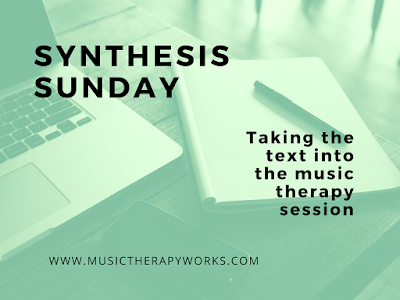Synthesis Sunday: Recapitulation of Chapters 1-5 - Mercedes Pavlicevic
This week, I am going to take some time to put together the thoughts that I've had during my reading of Music Therapy in Context: Music, Meaning and Relationship by Mercedes Pavlicevic. This is partially because I didn't get any reading done yesterday and I woke up late this morning, but it is partially because I've had lots of information come at me from this reading, and it is time to put it all together.
One of the biggest thoughts that I am processing through is that of cultural influence being always present - even if I am trying to engage in the music of another culture, my cultural experience will always be my primary filter. That makes sense to me, but I've never really thought it through completely, especially when it comes to how I process music.
Now, I've known for many years that my experience of music is different from how my siblings process music. This is due to my way of interacting (translation - many years of music history, theory, and study) versus my sister's way of interacting (some training but less coursework about the elements of music) and my brother's way of interacting (again some training and no coursework at all - mostly self-taught). They tend to use the music that they listen to in ways that I cannot - or maybe it's that I will not use music the same way. I wonder.
Anyway, my use and experience of music is not only based on my primary cultural experience and identity, but is has been shaped by sub-cultures. I am part of the small sub-culture known as "Music Therapy Professional." I am part of the larger sub-culture known as "Woman" and another one known as "Middle-Age." The list of sub-cultures goes on and on. Each one of those sub-cultural identities affects my interaction and experience with others in the world. There you go.
I did some initial individual music therapy sessions with two clients this week. We engaged in improvisation and exploratory play during the session. This was the first time that these clients had been in the music therapy room without their classroom group. There was some confusion in how they should proceed. Where should they sit? Could they actually play the drums that were out on the floor? Was the piano something available? Once they were aware of my expectations, we found our mutual way into interaction.
We made music together.
One student stayed at the piano most of the time during the session. I listened to his playing to help me use my playing to respond and react. We created our own sub-culture - "individual music therapy with client and MJ."
The process itself is something that I have made into a graphic. This is Pavlicevic's concept of improvisation into a visual that I can understand.
Chapter six delves a bit deeper into music psychology, so I anticipate that this graphic will become more complex as I keep reading.
Happy Sunday, all.
Pavlicevic, M. (1997). Music therapy in context: Music, meaning and relationship. London: Jessica Kingsley.
One of the biggest thoughts that I am processing through is that of cultural influence being always present - even if I am trying to engage in the music of another culture, my cultural experience will always be my primary filter. That makes sense to me, but I've never really thought it through completely, especially when it comes to how I process music.
Now, I've known for many years that my experience of music is different from how my siblings process music. This is due to my way of interacting (translation - many years of music history, theory, and study) versus my sister's way of interacting (some training but less coursework about the elements of music) and my brother's way of interacting (again some training and no coursework at all - mostly self-taught). They tend to use the music that they listen to in ways that I cannot - or maybe it's that I will not use music the same way. I wonder.
Anyway, my use and experience of music is not only based on my primary cultural experience and identity, but is has been shaped by sub-cultures. I am part of the small sub-culture known as "Music Therapy Professional." I am part of the larger sub-culture known as "Woman" and another one known as "Middle-Age." The list of sub-cultures goes on and on. Each one of those sub-cultural identities affects my interaction and experience with others in the world. There you go.
I did some initial individual music therapy sessions with two clients this week. We engaged in improvisation and exploratory play during the session. This was the first time that these clients had been in the music therapy room without their classroom group. There was some confusion in how they should proceed. Where should they sit? Could they actually play the drums that were out on the floor? Was the piano something available? Once they were aware of my expectations, we found our mutual way into interaction.
We made music together.
One student stayed at the piano most of the time during the session. I listened to his playing to help me use my playing to respond and react. We created our own sub-culture - "individual music therapy with client and MJ."
The process itself is something that I have made into a graphic. This is Pavlicevic's concept of improvisation into a visual that I can understand.
 |
| From pages 56-59 in Music Therapy in Context: Music, Meaning and Relationship by Mercedes Pavlicevic, re-visioned by me. |
Happy Sunday, all.
Pavlicevic, M. (1997). Music therapy in context: Music, meaning and relationship. London: Jessica Kingsley.


Comments
Post a Comment